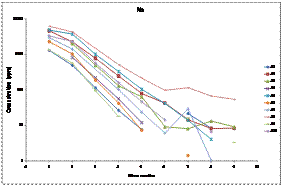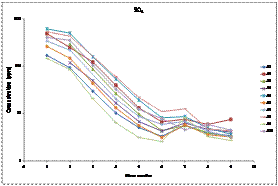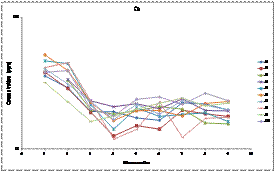

44141-AC2
The Development of the Sulfur Isotopic Composition of Carbonate Associated Sulfate as an Indicator of Diagenetic Environment in the Formation of Dolomite
44141-AC2
The Development of the Sulfur Isotopic Composition of Carbonate Associated
Sulfate as an Indicator of Diagenetic Environment in the Formation of Dolomite
The proposed work involved the assessment of the use of Non-Conventional Geochemical Indicators (NCGIs) to aid with the interpretation of diagenesis in carbonate systems, in particular concentrating on the processes of dolomitization (See previous progress reports for further details).
Removal of Contamination
In order to assess methods for the removal of contamination from the carbonate material, sediment samples from ODP Leg 182 Core 1129 were repeatedly leached with a series of distilled water rinses. 50 g sediment sub-samples were ground and sieved to a uniform size fraction of less than 63 mm and were rinsed with 100ml distilled water (DIW) for a total of 9 rinses. Samples were then rinsed with acetone, followed by 2 additional DIW rinses, and finally with sodium hypochlorite, followed by 2 final DIW rinses. Each rinse was allowed to soak for 24 hours, then samples were centrifuged and supernatant was decanted. Supernatant samples were collected and analyzed by ICP-OES to assess the efficiency of the rinse procedure. This rinse procedure was conducted on sediments which were originally formed in the marine environment, but later were influenced by porewater brines. These experiments showed that through progressively harsher treatments it was possible to reduce the concentration of NCGI elements to progressively lower values. Following 5 DIW rinses, values reach stability at relatively low values. As it is assumed that lower concentrations more accurately represent uncontaminated values, work is continuing to ascertain whether it is possible to reduce the concentration further. Analysis of the sediments deposited in marine environments and then subjected to different environment with significantly different geochemical characteristics is continuing. These environments include sediments from Florida Bay and from Leg 182 of the Ocean Drilling Program. We are also exploring methods of analyzing the concentration of chloride using ion chromatography.
After the contamination rinse procedure, 100mg of the residual sediment was dissolved in 4N nitric acid for ICP-OES analysis of the sediment chemistry. Core profiles of carbonate associated sulfate (CAS) concentrations are shown in comparison with corresponding porewater sulfate data, clearly demonstrating that the sulfate concentrations retained within the carbonate crystal lattice are not dependent on post depositional porewater interactions.
Sample preparation for measurement of d34S in the CAS fraction from core 1129 is thus complete. Development of the CF-IRMS instrumentation to facilitate isotope measurements is nearing completion. An inline sample combustion device has been constructed to specifications for S-isotope analysis of gaseous SO2 and the final phase of sensitivity tuning on the IRMS itself is underway.
Progress in 2008-2009
In 2008-2009 we subjected a core material from Site 1129 drilled during Leg 182 of the Ocean Drilling Program to the above procedure. This site was cored off the Great Australian Bight in 1996 and is of relevance to this study because (i) it contains abundant dolomite throughout which is clearly diagenetic in nature, (ii) it shows a range in pore water compositions from near normal seawater salinity to over three times the salinity of seawater, (iii) it shows a high amount of sulfate reduction in certain portions of the core. Because of the range of values in this core we will be able to apply our cleaning methods to the material, analyze the fluids from the cleaning solutions, analyze the NCGI elements in the solids, and analyze the d34S of the solids. The d34S of the pore fluids have already previously been measured.
Cleaning Experiments
The results of cleaning experiments for three of the NCGI elements as well as a conventional geochemical indicator are shown in Figure 1-4. Our data indicate that after about 6 washes the concentrations of the NCGI attain a constant value. In addition further contamination is removed in the final two treatments (See methods).
|
|
Figure 1a: Changes in the Na concentration as a result of repeated leaching of samples from Site 1129. Figure shows the decrease in concentration and the approach of a steady state condition. The final two steps of the treatment (see text) are not shown. | Figure 2: Changes in the sulfate (See Figure 1). Figure shows the decrease in concentration and the approach of a steady state condition. The final two steps of the treatment (see text) are not shown. |
|
|
Figure 3: Changes in the Ca concentration (See Figure 1). Calcium is not a NCGI element and there the initial decrease represents washed Ca from the salts evaporated onto the sample | Figure 4: Changes in the K (See Figure 1). Profile is similar to that of Na and sulfate. |



